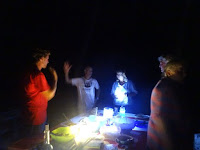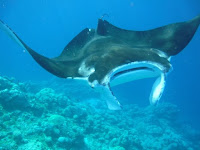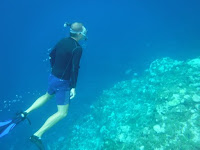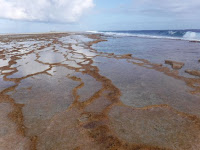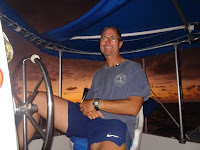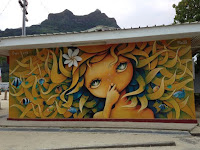



Sail to Beveridge Reef
Views from the passage
It did not. Everything was going great. I got Begonia carefully lined up on the bearing I had pre-scouted between our anchor trip line float and a certain palm tree on the beach (the medium one, with the fronds). Maryanne pulled up the chain without incident and laboriously stripped and stowed all of the intermediate floats. Just as we were nearing our anchor, I left the boat in forward gear just a second or two too long. The chain slackened and sagged and the bight of the loop tucked itself right into a slot between the sand and the underside of a big bommie. That took all of the slack out of the chain. As we rose on the next little wavelet, it pulled really tight. That put way too much strain on our windlass. Maryanne tried to let out more chain to reduce the tension, but all it would do is click, but not turn in either direction. Why does it always have to be more than one thing at a time?
I put out a call for help on the radio. There were plenty of people standing by for such an event, but Nick from Urchin was first in the water almost as soon as I had unkeyed the mic. Maryanne and I swapped places. Nick directed her from the water to get some slack in the chain (which we could do manually) and keep it away from other bommies. Once she had done all of that, he dove down and manhandled it out from under the coral head and surfaced to tell me to hoist. Since the windlass was out of commission and since operating it with the manual backup handle is really slow, I opted to retrieve it hand over hand. I didn’t want to give the anchor time to snag anything else on the way up. Damn, that thing is heavy! 10m of chain and our anchor weighs about 50 kilos (110lbs). That’s a lot of weight to pull up by pulling one hand at a time on a wet chain. When it was up and stowed, I tried the windlass controls again. Up – click! Down – click! No movement.
Maryanne and I switched again. I steered us out of the lagoon while she stood on the bow looking for hazards. Just as we were getting to the narrowest, shallowest part of the pass, Catherine from La Cigale called Maryanne to wish us Bon Voyage. She’s six years old and had decided Maryanne was her new best friend the evening before. She wanted to give us a long farewell, complete with stories that meander in the aimless way of those narrated by six year olds. I think she may have included a little song as well. We were in a bit of a high workload environment at that exact moment, so we couldn’t devote as much of our attention to our end of the conversation as she was, but we were touched nonetheless.
Harlequin departed shortly thereafter and soon we were both outside the reef, ticking off motus and enjoying a fast sail in the calm waters in the lee of the atoll. When we got to its western extreme, we carried on hugging the reef while they continued straight on toward Samoa.
At the southern tip, we met the big ocean swell head on as it wrapped around the other side of the atoll. We bore off and sailed fast across beam seas that rolled us just enough to make it really uncomfortable. We had another day and a half of that until the wind finally let up and we slowly coasted to a stop on a sea with only a hint of a swell from a distant storm tearing up the Roaring Forties almost two thousand miles away.
With the wind and the waves gone, all of the other little noises of the boat floated to the surface. I spent an hour and a half on one watch crawling all over the boat, trying to track down the annoying sound of something that had broken loose. It turned out to be a little container of spices that had fallen over and was rolling around in the space in the cupboard below the rack.
We had a Noon to Noon run of just 27 nautical miles. That’s way below walking speed. 26.5 of those were sailed before 8am. Then it was 0.49, 0.01 (60 feet!), 0.00 and 0.00 each hour thereafter. At least the current was going in the right direction.
A wall of gray clouds approached from the south. There was a blast of wind from that direction, followed shortly by pelting rain. The rain finished a couple of hours later, but left behind the wind for us so we could get moving again. Within a few more hours, we were sailing a little close to a little too much wind. We were back to rolling around in beam seas again and wishing our new wind would taper off just a bit so it was easier for the off watch to sleep.
Two fast days later, we spotted some suspicious looking waves on the horizon. I turned on the radar and played with the gain until it showed just the crests of the breakers as they formed the familiar outline of Beveridge Reef. We hadn’t seen or heard any sign of anybody since Suwarrow and I was starting to hope we might actually get away with having it to ourselves. There’s something nice about having a little patch of international waters to rule over without the burden of keeping watches. Without having to democratically include the inputs of others, we can make a little society using only the rules and traditions we want.
Some examples:
- In the Republic of Begonia, no alarm shall be used to wake a sleeping citizen.
- No work is to be undertaken prior to the finishing of morning coffee.
- Cocktail Hour may be commenced any time following the completion of the work from Rule 2.
- On clear nights, stargazing is mandatory.
- Certain days may be arbitrarily declared Clothing Optional.
Then an AIS target popped up. It was not moving and it was positioned inside the reef. Aw, Man! So much for Naked Thursday. A little closer in, the rest of the data tag arrived. The boat was Ganesh, home to Cap’n Fatty and Carolyn Goodlander. For those of you that don’t know of him, Cap’n Fatty is the Editor at Large of Cruising World magazine. Maryanne and I have been reading his writing since he was a freelancer who managed to occasionally get a column printed on the third to last page. What I liked about him especially was that he seemed to be the token Cruiser in the magazine. The other columnists were all sellouts who gushed about the expensive yachts advertized in their pages as the perfect boats for whichever niche they were marketed, or they would write segments about cruising in some nice area of the world, which would seem great until you realized little actual sailing was involved and that it was just thinly disguised ad copy for some charter company.
Fatty was different. He was always broke because he cares more about sailing than money, so he has had very little, but he’s been everywhere. Instead of the perfect new winch handle, he writes about sailing into the sunset, tropical landfalls and how free he feels wandering the world as a sea gypsy. Reading one of his columns, it’s pretty much guaranteed that I’ll get a little choked up. If there was going to be another boat in the anchorage, Ganesh was the least likely to offend my imperial ambitions. We’ll take North Beveridge, they can have the South.
Carolyn spotted us and got on the radio to say they were monitoring the frequency. We called to introduce ourselves and they were surprisingly sociable. I expected they had come to get some time to themselves, but they were quite welcoming and promised to get together with us as soon as we had had some rest and the wind died down a bit.
Since our windlass was not working, we did not need to run the port engine running to deploy the anchor. We (I) decided to drop it manually under sail for a little variety. We made a couple of tacks down the western side of the reef to the pass and then sailed in. Once inside, we tightened the sheets and sailed close hauled right at Ganesh. I could imagine they must have been cursing themselves for being so friendly. We had a whole reef to choose from, but we had every appearance of intending to anchor right on top of them.
Just kidding! It’s all part of our anchoring plan. When we got near, we bore off so the wind was now behind us. We then rolled up the jib and headed for a spot near the old wreck of a steel fishing boat. We pulled up on the sand shelf behind the reef, rounded up into the wind to stop the boat, dropped the anchor and drifted back. Once we were done, we “shut down the engines” by meandering back and lowering the mainsail neatly onto its bag on the boom. That’s my kind of arrival!











